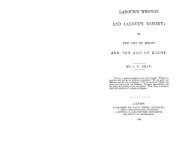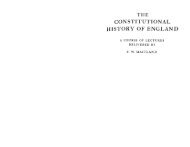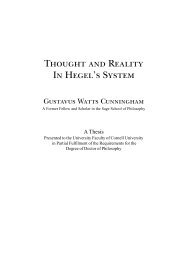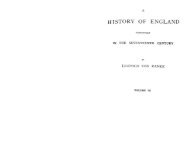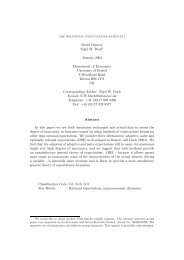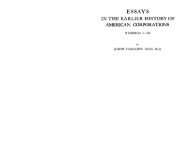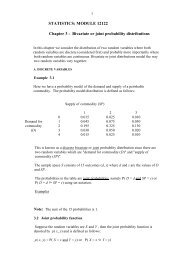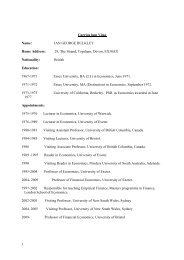CONCLUSIONwere specially deprecated. Milton's statement sumsup very fairly the ideas <strong>of</strong> this school <strong>of</strong> thoughtregarding the relations that should exist betweenhusband and wife in the general scheme <strong>of</strong> things.They were to exist " He for God only, she for Godin him." The general standard <strong>of</strong> education resultingfrom such theories was inevitably inferior ; and theexclusion <strong>of</strong> <strong>women</strong> from skilled industry and, t%epr<strong>of</strong>essions, was equally certain to be the consequencesooner or later, <strong>of</strong> the absence <strong>of</strong> specialised training.The general effect upon <strong>women</strong> <strong>of</strong> this exclusion,which ultimately limited their productive capacityto the field <strong>of</strong> household i! xdgery, or to the lowestpaid ranks <strong>of</strong> unskilled labour, belongs to a muchlater period. But one point can already be discernedand must not be overlooked. This point is the alterationwhich took place in the value to her family <strong>of</strong>a woman's productive capacity when her labour wastransferred from domestic industry to wage-earning,under the conditions prevailing in the <strong>seventeenth</strong><strong>century</strong>. When employed in domestic industrythe whole value <strong>of</strong> what she produced was retainedby her family; but when she worked for wages herfamily only received such a proportion <strong>of</strong> it as she wasable to secure to them by her weak bargaining power inthe labour market. What this difference amounted towill be seen when it is remembered that the wife <strong>of</strong>a husbandman could care for her children and feedand clothe herself and them by domestic industry,but when <strong>working</strong> for wages she could not earn enoughfor her own maintenance.This depreciation <strong>of</strong> the woman's productive valueto her family did not greatly influence her positionin the <strong>seventeenth</strong> <strong>century</strong>, because it was then onlyvisible in the class <strong>of</strong> wage-earners, and into thisposition <strong>women</strong> were forced by poverty alone. Theproductive efficiency <strong>of</strong> <strong>women</strong>'s services in domesticindustry remained as high as ever, and every familyCONCLUSIONwhich was possessed <strong>of</strong> sufficient capital for domesticindustry, could provide sufficient pr<strong>of</strong>itable occupationfor its <strong>women</strong> without their entry into the labourmarket. Independent hard-<strong>working</strong> families livingunder the conditions provided by Family andDomestic Industry, still formed the majority <strong>of</strong>the English people. The upper classes, as faras the <strong>women</strong> were concerned, were becoming moreidle, and the number <strong>of</strong> families depending whollyon wages was increasing, but farmers, husbandmen andtradesmen, still formed a class sufficiently numerousto maintain the hardy stock <strong>of</strong> the English race unimpaired.Thus, while the productive capacity <strong>of</strong><strong>women</strong> was reduced in the <strong>seventeenth</strong> <strong>century</strong>by the idleness <strong>of</strong> the nouveau riche and by the inefficiency<strong>of</strong> <strong>women</strong> wage-earners which resulted fromtheir lack <strong>of</strong> nourishment, it was maintained at theformer high level among the intermediate and muchlarger class, known as " the common people."Though from the economic point <strong>of</strong> view intenseproductive energy on the part <strong>of</strong> <strong>women</strong> is no longernecessary to the existence <strong>of</strong> the race, and has beengenerally abandoned, an understanding <strong>of</strong> its effectupon the maternal functions is extremely importantto the sociologist. No complete vital statisticswere collected in the <strong>seventeenth</strong> <strong>century</strong>, but anexamination <strong>of</strong> the different evidence which is stillavailable, leaves no doubt that the birth rate wasextremely high in all classes, except perhaps that <strong>of</strong>wage-earners. It was usual for active busy <strong>women</strong>amongst the nobility andgentry, to bear from twelveto twenty children, and though the death rate wasalso high; the children that survived appear to havepossessed abundant vitality and energy. Neither doesthe toil which fell to the lot <strong>of</strong> the <strong>women</strong> among thecommon people appear to have injured their capacityfor motherhood; in fact the wives <strong>of</strong> husbandmenwere the type selected by the wealthy to act as wet nurses
CONCLUSION CONCLUSION 307for their children. It is only among the class <strong>of</strong> wageearnersthat the capacity for reproduction appearsto have been checked, and in this class it was the underfeeding,rather than the over-<strong>working</strong> <strong>of</strong> the mothers,which rendered them incapable <strong>of</strong> rearing their iniants.The effect <strong>of</strong> the economic position <strong>of</strong> <strong>women</strong>, mustbe considered also in relation to another specialfunction which <strong>women</strong> exercise in society, namelythe part which they play in the psychic and moralreactions between the sexes. This subject has seldombeen investigated in a detached and truly scientificspirit, and therefore any generalisations that may besubmitted have little value. It will only be observedhere that the exercise by <strong>women</strong> <strong>of</strong> productive energyin the Elizabethan period, was not then inconsistentwith the attainment by the English race <strong>of</strong> its highwatermark in vitality and creative force, and that acomparison <strong>of</strong> the social standards described by Restorationand Elizabethan Dramatists, reveals a decadence,which, if not consequent upon, was at least coincidentwith, the general withdrawal <strong>of</strong> upper-class <strong>women</strong>from their previous occupation with public and privateaffairs.Undoubtedly the removal <strong>of</strong> business and publicinterests from the home, resulted in a loss <strong>of</strong> educaticnalopportunities for girls ; a loss which was not made goodto them in other ways, and which therefore producedgenerations <strong>of</strong> <strong>women</strong> endowed with a lower mentaland moral calibre. The influence <strong>of</strong> <strong>women</strong> upontheir husbands narrowed as men's lives drifted awayfrom the home circle and centred more roundclubs and external business relations. Hence it cameabout that in the actual social organisation prevailingin England during the last half <strong>of</strong> the <strong>seventeenth</strong><strong>century</strong>, the influence or psychic reaction <strong>of</strong> <strong>women</strong>upon men was very different in character and muchmore limited in scope, than that exercised by themin the Elizabethan period. When considered inregard to the historical facts <strong>of</strong> this epoch, it will benoticed that the process by which the vital forcesand energy <strong>of</strong> the people were lowered and which incommon parlance is termed emasculation, accompaniedan evolution- which was in fact depressing thefemale forces <strong>of</strong> the nation, leaving to the male forcesan ever greater predominance in the directing <strong>of</strong> thepeople's destiny. The evidence given in the precedingchapters is insufficient to determine what is cause andwhat is effect in such complicated issues <strong>of</strong> <strong>life</strong>, and onlyshows that a great expenditure <strong>of</strong> productive energyon the part <strong>of</strong> <strong>women</strong> is not, under certain circumstances,inconsistent with the successful exercise <strong>of</strong>their maternal functions, nor does it necessarilyexhaust the creative vital forces <strong>of</strong> the race.The enquiry into the effect which the appearance<strong>of</strong> Capitalism has produced upon the economic position<strong>of</strong> <strong>women</strong> has drawn attention to another isssue,which concerns a fundamental relation <strong>of</strong> humansociety, namely to what extent does the Communityor ~tite include <strong>women</strong> among its integral members,and provide them with security for the exercise<strong>of</strong> their functions, whether these may be <strong>of</strong> thesame character or different from those <strong>of</strong> men.It has been suggested that the earlier EnglishCommonwealth did .actually embrace both men and<strong>women</strong> in its idea <strong>of</strong> the " Whole," because it wascomposed <strong>of</strong> self-contained families consisting <strong>of</strong>men, <strong>women</strong> and children, all three <strong>of</strong> which areessential for the continuance <strong>of</strong> human society ;but the mechanical State which replaced it, and whosedevelopment has accompanied the extension <strong>of</strong> Capitalism,has regarded the individual, not the family,as its unit, and in England this State began with theconception that it was concerned only with maleindividuals. Th.us it came to pass that every womanlyfunction was considered as the private interest <strong>of</strong>husbands and fathers, bearing no relation to the <strong>life</strong>
- Page 1 and 2:
WORKING LIFE OF WOMENIN THESEVENTEE
- Page 6 and 7:
4 INTRODUCTORYtragic class of wage
- Page 8 and 9:
8 INTRODUCTORY INTRODUCTORYDomestic
- Page 10 and 11:
INTRODUCTORYunmarried girls go out
- Page 12 and 13:
I 6 CAPITALISTS CAPITALISTS" I loos
- Page 14 and 15:
CAPITALISTSweak woman stands in the
- Page 16 and 17:
24 CAPITALISTS CAPITALISTS 25wife t
- Page 18 and 19:
2 8 CAPITALISTS CAPITALISTS 29Majes
- Page 20 and 21:
32 CAPITALISTSA warrant was issued"
- Page 22 and 23:
CAPITALISTSbusiness. " At O~tend, N
- Page 24 and 25:
CAPITALISTS CAPITALISTS41thro' her
- Page 26 and 27:
AGRICULTUREwas made of their develo
- Page 28 and 29:
AGRICULTUREis not drye as it should
- Page 30 and 31:
52 AGRICULTURE AGRICULTUREhave of h
- Page 32 and 33:
56 AGRICULTUREfor colonists in Virg
- Page 34 and 35:
AGRICULTUREmaintain completely the
- Page 36 and 37:
64 AGRICULTUREtime was well spent i
- Page 38 and 39:
AGRICULTUREExcept in exeptional cir
- Page 40 and 41:
72 AGRICULTURE AGRICULTURE 73mainta
- Page 42 and 43:
76 AGRICULTUREfor the impotent poor
- Page 44 and 45:
AGRICULTUREwhich we can imagine tha
- Page 46 and 47:
AGRICULTURE AGRICULTURE 85by his se
- Page 48 and 49:
AGRICULTUREher work, but generosity
- Page 50 and 51:
AGRICULTUREwife of Thos. Lyne. Toba
- Page 52 and 53:
TEXTILESwas paid better than the la
- Page 54 and 55:
TEXTILESroof provided them with the
- Page 56 and 57:
104 TEXTILESformulated by 25 Charle
- Page 58 and 59:
108 TEXTILES TEXTILES 109until the
- Page 60 and 61:
TEXTILESon spinning for their livin
- Page 62 and 63:
TEXTILESstill and dry within Doors,
- Page 64 and 65:
120 TEXTILES TEXTILESthe cloth made
- Page 66 and 67:
124TEXTILES TEXTILESin the closely
- Page 68 and 69:
TEXTILESKingdom, it required a grea
- Page 70 and 71:
132 TEXTILES TEXTILESnot exceedl6 1
- Page 72 and 73:
TEXTILES TEXTILES I37hours in four
- Page 74 and 75:
---P-I 4OTEXTILEScan be quoted of t
- Page 76 and 77:
'44 TEXTILES TEXTILESWood Streate,
- Page 78 and 79:
TEXTILEShigher wages than would hav
- Page 80 and 81:
1 52 CRAFTS AND TRADESdebts. For ex
- Page 82 and 83:
I 56 CRAFTS AND TRADES CRAFTS AND T
- Page 84 and 85:
160 CRAFTS AND TRADES CRAFTS AND TR
- Page 86 and 87:
164 CRAFTS AND TRADESAmong thirty-n
- Page 88 and 89:
CRAFTS AND TRADESalso met with as b
- Page 90 and 91:
172 CRAFTS AND TRADES CRAFTS AND TR
- Page 92 and 93:
176 CRAFTS AND TRADESto Henry Joyce
- Page 94 and 95:
180 CRAFTS AND TRADES CRAFTS AND TR
- Page 96:
CRAFTS AND TRADESWardens and Brothe
- Page 99 and 100:
P-I9OCRAFTS AND TRADESmarriage ; it
- Page 101 and 102:
CRAFTS AND TRADEStaken our goods fr
- Page 103 and 104:
1g8CRAFTS AND TRADESresources turne
- Page 105 and 106: CRAFTS AND TRADESThere were fewer r
- Page 107 and 108: 206 CRAFTS AND TRADES CRAFTS AND TR
- Page 109 and 110: CRAFTS AND TRADESA large proportion
- Page 111 and 112: 214CRAFTS AND TRADES CRAFTS AND TRA
- Page 113 and 114: 218 CRAFTS AND TRADES CRAFTS AND TR
- Page 115 and 116: 222 CRAFTS AND TRADES CRAFTS AND TR
- Page 117: CRAFTS AND TRADES CRAFTS AND TRADES
- Page 120 and 121: CRAFTS AND TRADESfrom her fellow pa
- Page 122 and 123: PROFESSIONS 237PROFESSIONSIntroduct
- Page 124 and 125: 24O PROFESSIONS PROFESSIONStheir Th
- Page 126 and 127: 244 PROFESSIONS PROFESSIONS 245the
- Page 128 and 129: PROFESSIONS PROFESSIONS 249profanat
- Page 130 and 131: 252PROFESSIONSGiles Moore enters in
- Page 132 and 133: PROFESSIONScribed as one who " dist
- Page 134 and 135: PROFESSIONS PROFESSIONS 261first ma
- Page 136 and 137: 264 PROFESSIONSGarrett's leg shall
- Page 138 and 139: 268 PROFESSIONSwhere there are none
- Page 140 and 141: PROFESSIONS PROFESSIONS 273the numb
- Page 142 and 143: PROFESSIONSexaminations, before six
- Page 144 and 145: PROFESSIONS PROFESSIONS 281death me
- Page 146 and 147: 284 PROFESSIONS PROFESSIONSof confi
- Page 148 and 149: 288 PROFESSIONSextent they were whe
- Page 150 and 151: CONCLUSIONor in her other facilitie
- Page 152 and 153: CONCLUSION CONCLUSION 297in women's
- Page 154 and 155: CONCLUSIONlaw of Nature, inviolable
- Page 158 and 159: 308 CONCLUSIONof the State, and the
- Page 160 and 161: 312 AUTHORITIES AUTHORITIES 313Cost
- Page 162 and 163: AUTHORITIESMartindale, Adam, The Li
- Page 164 and 165: County.Buckingham ..Cardigan .. ..C
- Page 166 and 167: INDEXINDEXFlax, 64, 146, 246, 291 ;
- Page 168: INDEXsmants, women( 50,65,157 ; mam



